Introduction to Tai Chi Exercises to Do at Home: Discover the Art and Benefits
Welcome to our guide on Tai Chi exercises to do at home! Whether you’re new to Tai Chi or a seasoned practitioner, practicing at home can offer numerous benefits for both body and mind. In this article, we’ll explore some home tai chi routines that are easy to learn yet effective in promoting relaxation, balance, and overall well-being.
Tai chi, often referred to as “moving meditation,” is an ancient Chinese martial art known for its gentle, flowing movements and emphasis on mindfulness. Originating centuries ago, tai chi has evolved into a popular form of exercise worldwide, valued for its ability to reduce stress and improve flexibility.
Imagine starting your day with a series of Tai Chi exercises to practice at home, gently moving through each posture as you synchronize your breath with your movements. This practice not only wakes up your body but also prepares your mind for the day ahead, promoting a sense of calm and focus that can carry through your daily activities.
For many, the idea of practicing Tai Chi exercises at home may seem daunting at first. However, with a bit of guidance and practice, you can incorporate Tai Chi into your daily routine effortlessly. The beauty of tai chi lies in its simplicity and accessibility – you don’t need any special equipment or a large space to reap its benefits.
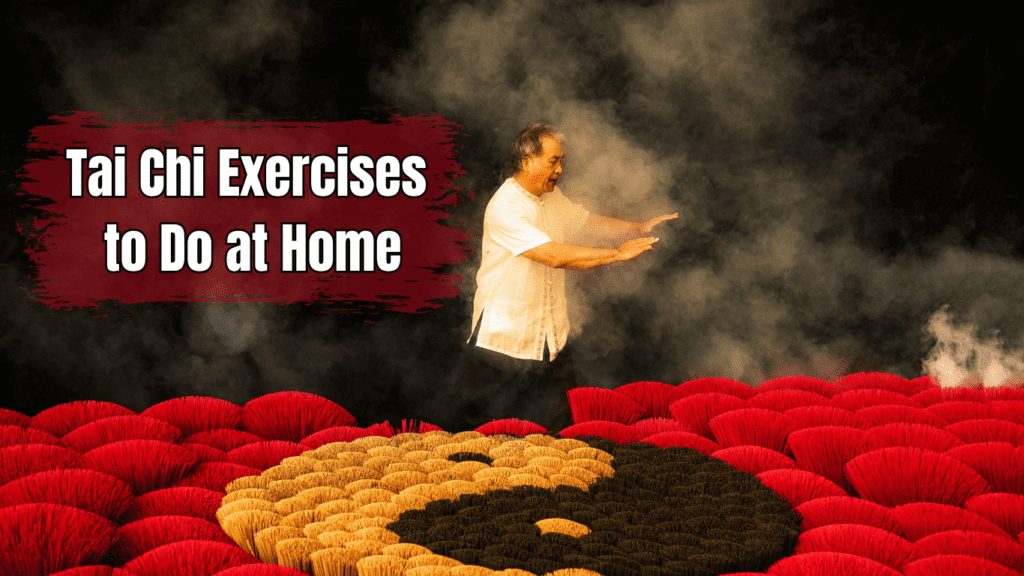
One of the key principles of home tai chi routines is slow, deliberate movements. Each posture flows gracefully into the next, promoting relaxation and improving circulation throughout your body. This deliberate pace allows you to fully engage with each movement, enhancing both physical and mental awareness.
Research has shown that regular practice of tai chi exercises at home can improve balance and stability, which is especially beneficial for older adults looking to maintain their independence and reduce the risk of falls. By focusing on controlled movements and proper posture, tai chi helps strengthen muscles and joints, supporting overall mobility.
In addition to its physical benefits, home tai chi routines also promote mental clarity and emotional well-being. As you move through the gentle, flowing sequences, you cultivate a sense of mindfulness and inner peace. This meditative aspect of tai chi can help reduce anxiety and improve sleep quality, contributing to a healthier lifestyle overall.
Subscribe And Get Our Free E-Book:Unlocking The Power Of Nutrition-Supplements, Substitutes, and Superfoods!
Now, let’s explain deeper Tai Chi and explore some specific tai chi exercises for home practice that you can incorporate into your daily routine. These exercises are designed to be beginner-friendly yet effective in harnessing the power of tai chi for your well-being. Remember, consistency is key when practicing tai chi – even a few minutes each day can make a significant difference in how you feel.
Begin with a simple warm-up to prepare your body for home tai chi routines. Focus on gentle stretches and deep breathing to relax your muscles and center your mind. Once you feel ready, move into the first posture: tai chi exercises to do at home.
What is Tai Chi?
In this section, we delve deeper into the essence of tai chi exercises to do at home, exploring its rich history, foundational philosophy, and myriad benefits for both body and mind.
What is Tai Chi?
Origins: Tai chi, also known as tai chi chuan, traces its origins to ancient China, where it emerged as a martial art deeply rooted in Taoist principles and traditional Chinese medicine. Developed over centuries, tai chi originally served as a method of self-defense, blending soft, flowing movements with strategic combat techniques. Over time, its practice evolved beyond martial applications to encompass broader health and wellness benefits, making it accessible to people of all ages and fitness levels.
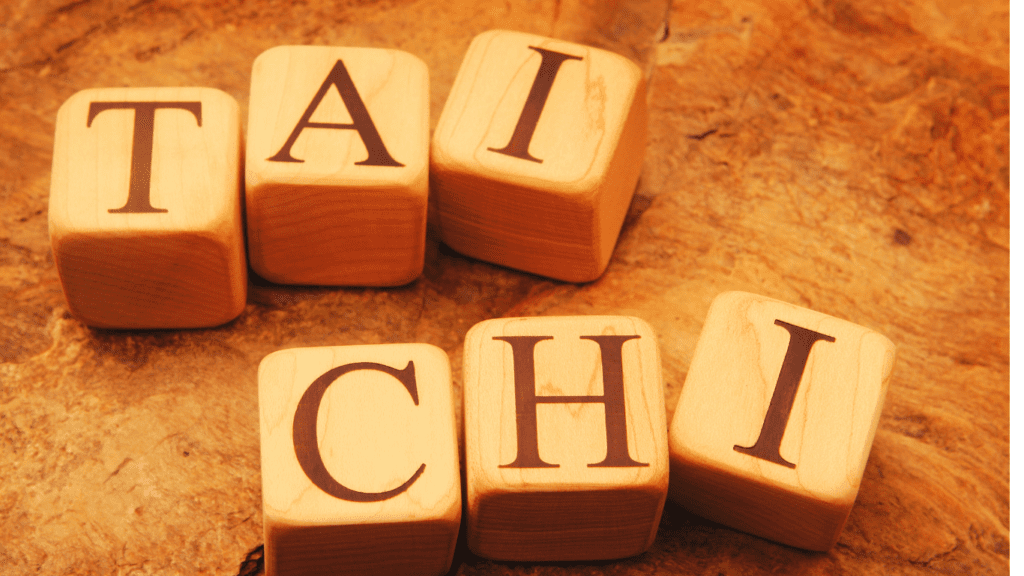
Philosophy: At the heart of tai chi lies a profound philosophy that harmonizes movement, breath, and mindfulness. Central to this philosophy is the concept of Yin-Yang balance, symbolizing the interconnectedness and complementary nature of opposing forces. Practitioners of tai chi seek to cultivate a harmonious balance within themselves, aligning body, mind, and spirit through deliberate, fluid movements. Another fundamental principle is Qi (pronounced “chee”), the vital life force believed to flow through the body’s energy pathways (meridians). Through tai chi practice, individuals aim to enhance the smooth circulation of Qi, promoting overall health and vitality. Mindfulness is also integral to tai chi, encouraging practitioners to maintain present-moment awareness and cultivate a calm, focused state of mind during each movement sequence.
Benefits: The benefits of tai chi exercises to do at home extend far beyond physical fitness, encompassing a holistic approach to well-being.
Physical Benefits: Regular practice of tai chi can lead to improved balance, coordination, and flexibility. The slow, controlled movements help strengthen muscles and joints while enhancing overall stability. This is particularly beneficial for older adults seeking to maintain mobility and reduce the risk of falls. Additionally, tai chi promotes better posture and alignment, which can alleviate chronic pain and tension in the body.
Mental Benefits: Tai chi serves as a powerful tool for stress reduction and relaxation. Its gentle, rhythmic movements encourage deep breathing and mindfulness, fostering a sense of inner peace and emotional balance. Practicing tai chi regularly has been shown to lower levels of cortisol, the stress hormone, thereby promoting a more relaxed state of being. Moreover, tai chi enhances cognitive function and mental clarity, sharpening focus and concentration through its meditative qualities. This mental clarity extends beyond the practice session, helping practitioners navigate daily challenges with a heightened sense of awareness and resilience.
In summary, tai chi exercises to do at home offer a holistic approach to health and wellness, rooted in centuries-old traditions and supported by modern research. By understanding the origins, philosophy, and benefits of tai chi, you can embark on a journey toward improved physical vitality and mental well-being. Whether you’re looking to enhance your fitness regimen, manage stress more effectively, or simply cultivate a deeper connection between mind and body, integrating tai chi exercises to do at home into your daily routine can be a transformative step toward a healthier, more balanced lifestyle.
Preparing Your Space for Tai Chi Exercises to Do at Home
Now, let’s focus on preparing your space for tai chi exercises to do at home. Creating a conducive environment can greatly enhance your practice, allowing you to fully immerse yourself in the gentle movements and mindfulness of tai chi.
Space Requirements: When selecting a space for your tai chi exercises to do at home, prioritize openness and freedom of movement. Ideally, choose an area that allows you to extend your arms fully in all directions without obstruction. A spacious room or even an outdoor setting can work well, providing ample room for the fluid, circular motions characteristic of tai chi. Ensure the floor is a non-slip surface to prevent any accidents during your practice.
Ambiance: Setting the right ambiance can significantly impact your tai chi experience. Aim for a quiet and peaceful environment that promotes relaxation and focus. Consider soft lighting to create a serene atmosphere, especially if you’re practicing in the evening or early morning. Some practitioners find gentle, instrumental music or nature sounds beneficial for enhancing mindfulness and concentration during tai chi exercises at home. Experiment with different ambient settings to discover what resonates best with your practice.
Equipment: One of the beauties of tai chi exercises to do at home is its minimal equipment requirement. You don’t need elaborate gear or machinery to enjoy its benefits. However, there are a few optional items that can enhance your comfort and enjoyment. For instance, a Tai Chi mat or simply a non-slip yoga mat can provide added cushioning and stability, particularly if you’re practicing on a hard surface. Comfortable, loose-fitting clothing allows for unrestricted movement and helps you stay cool and comfortable throughout your session. Remember, the essence of tai chi lies in its simplicity and accessibility, so feel free to adapt your setup to suit your personal preferences and needs.
Creating a dedicated space for tai chi exercises to do at home not only supports your physical practice but also nurtures a deeper connection with the meditative aspects of this ancient art form. By preparing a welcoming environment that encourages relaxation and mindfulness, you set the stage for a fulfilling and rejuvenating experience each time you practice. Whether you choose to practice indoors or outdoors, the key is to prioritize comfort, safety, and the ability to move freely as you engage in the graceful movements of tai chi.
In conclusion, by thoughtfully preparing your space and attending to these practical considerations, you can optimize your tai chi exercises to do at home experience. Embrace the opportunity to cultivate tranquility and wellness within the comfort of your own surroundings, knowing that each session contributes to your overall health and well-being. With these foundational elements in place, you are ready to embark on a journey of self-discovery and holistic growth through the practice of tai chi.
Basic Tai Chi Movements
Now, let’s explore some basic tai chi exercises to do at home that are perfect for beginners. These foundational movements will help you build a strong understanding of tai chi while reaping its numerous health benefits.
Selection of Movements: When starting with tai chi exercises to do at home, it’s essential to begin with simple, beginner-friendly movements that allow you to focus on correct form and alignment. Three classic movements to consider are “Ward Off,” “Grasp the Sparrow’s Tail,” and “Wave Hands Like Clouds.” These movements are foundational in tai chi practice, helping to cultivate balance, coordination, and mindfulness. Each movement flows smoothly into the next, creating a seamless sequence that promotes relaxation and inner harmony.
Explanation: Let’s break down these tai chi exercises to do at home step-by-step:
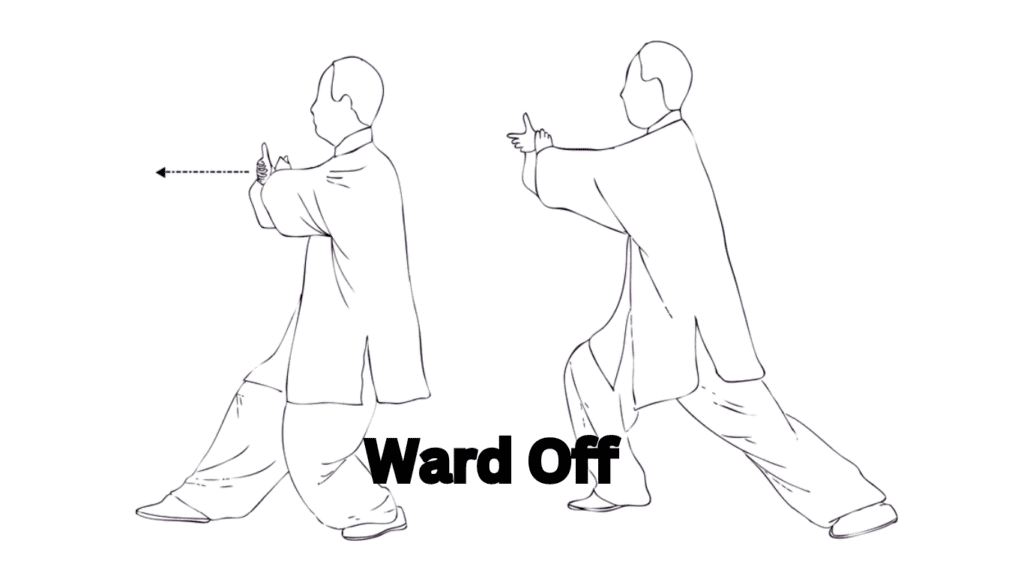
Ward Off: Start with your feet shoulder-width apart, knees slightly bent. Shift your weight to one leg as you gently raise both arms in front of you, palms facing outward. Imagine warding off an imaginary opponent with a gentle, circular motion of your arms. Maintain a relaxed posture with soft, flowing movements, keeping your spine straight and shoulders relaxed.
Grasp the Sparrow’s Tail: Begin in a neutral standing position. Shift your weight to one leg and step forward with the opposite foot, forming a bow stance. As you do so, bring your hands together in front of your chest, palms facing each other. Slowly separate your hands, one moving upward and the other downward, as if gently grasping the tail of a sparrow. This movement sequence emphasizes the coordination of upper and lower body movements, promoting balance and flexibility.
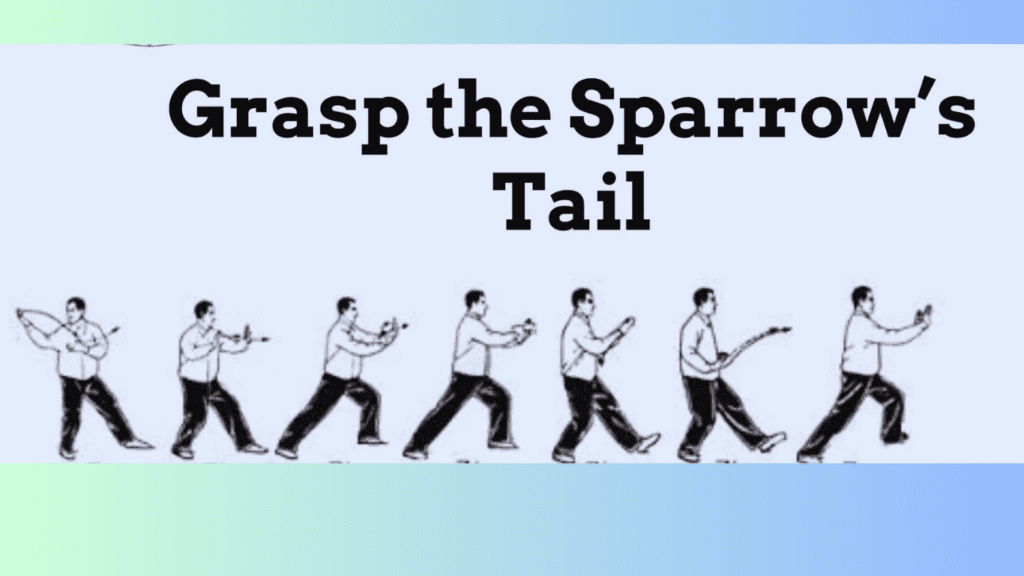
3.Wave Hands Like Clouds: Stand with feet shoulder-width apart, knees slightly bent. Begin with one hand extended forward at chest height, palm facing down, while the other hand rests at your side. Shift your weight to one leg and gently shift your torso to the side, allowing the extended hand to arc gracefully across your body, following a cloud-like pattern. As you shift your weight to the other leg, the movement repeats with the opposite hand. This sequence promotes fluidity and relaxation, encouraging the continuous flow of energy throughout the body.
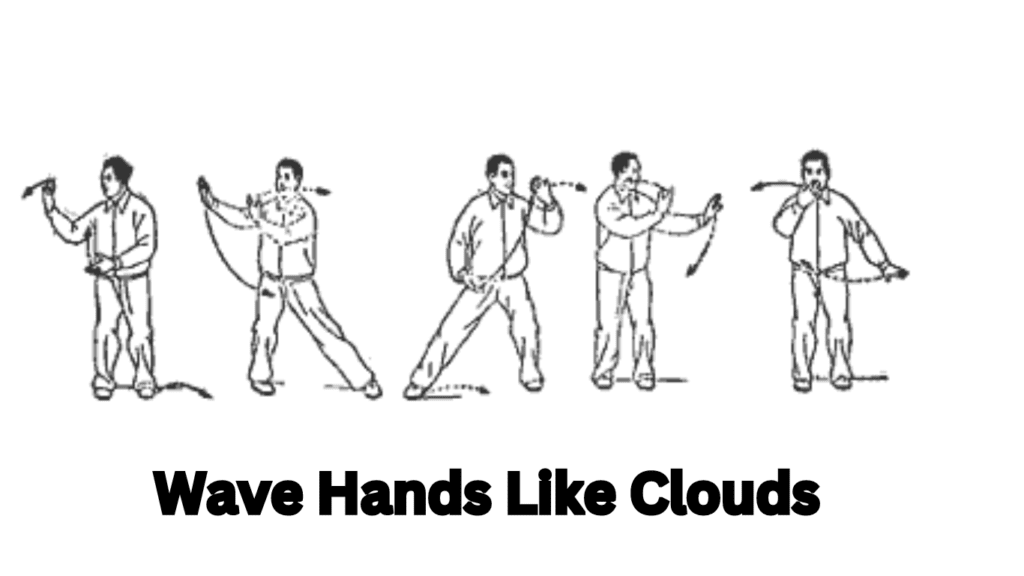
In each of these tai chi exercises to do at home, focus on maintaining a relaxed demeanor and steady breathing. Proper posture is crucial – keep your spine erect, shoulders dropped, and knees slightly bent to support a rooted stance. The essence of tai chi lies in its slow, deliberate movements that engage both the body and mind, fostering a sense of mindfulness and inner peace.
By practicing these basic tai chi exercises at home regularly, you’ll gradually build strength, improve flexibility, and enhance overall well-being. Don’t be discouraged if you find the movements challenging at first – tai chi is a journey of continuous learning and refinement. With patience and persistence, you’ll begin to experience the profound benefits of this ancient practice in your daily life.
These foundational tai chi exercises to do at home serve as an excellent starting point for beginners eager to explore the art of tai chi. Embrace the opportunity to deepen your understanding of each movement, paying attention to detail and cultivating a mindful approach to practice. As you progress, you’ll discover how tai chi exercises to do at home can enrich your physical health, mental clarity, and overall quality of life.
Warm-Up and Cool-Down
As you embark on your journey of practicing tai chi exercises to do at home, it’s essential to prioritize both warming up your body before and cooling it down after each session. These preparatory and recovery phases not only enhance the effectiveness of your practice but also contribute to your overall well-being.
Warm-Up: Before diving into your tai chi exercises to do at home, it’s crucial to warm up your body gently to increase blood flow to the muscles and joints. Begin with gentle exercises such as neck rolls, shoulder circles, and ankle rotations. These movements help loosen tight muscles and joints, preparing them for the fluid, controlled movements of tai chi. Focus on maintaining a steady pace and listening to your body’s cues. The goal of the warm-up is to gradually elevate your heart rate and increase flexibility without causing strain or discomfort.
Cool-Down: Just as important as warming up is cooling down after your tai chi exercises at home. A proper cool-down helps your body transition from physical activity to a state of rest and recovery. Incorporate gentle stretches that target major muscle groups, such as hamstring stretches, quadriceps stretches, and calf stretches. Hold each stretch for 15-30 seconds, focusing on deep, controlled breathing to promote relaxation and release tension. This helps prevent muscle soreness and stiffness, allowing your body to recover more effectively.
Additionally, practice deep breathing exercises during your cool-down phase. Slow, deep breaths help calm the nervous system and reduce stress levels, enhancing the overall benefits of your tai chi practice. Close your eyes if comfortable and focus on inhaling deeply through your nose, allowing your abdomen to expand fully, then exhaling slowly through your mouth. This mindful breathing technique encourages a sense of inner peace and mental clarity, aligning with the meditative aspects of tai chi exercises to do at home.
By incorporating a comprehensive warm-up and cool-down routine into your tai chi exercises at home, you not only optimize your physical performance but also nurture your mental and emotional well-being. Treat each session as an opportunity to reconnect with yourself, promoting a harmonious balance between body and mind. Remember, consistency is key when it comes to reaping the full benefits of tai chi, so prioritize your warm-up and cool-down as integral parts of your practice routine.
By dedicating time to both warming up and cooling down before and after your tai chi exercises to do at home, you set the stage for a fulfilling and sustainable practice. Embrace the opportunity to care for your body’s needs while fostering a deeper connection with the ancient art of tai chi. With each session, allow yourself to experience the transformative power of mindful movement and intentional relaxation. By integrating these essential elements into your practice, you cultivate a holistic approach to health and wellness that extends far beyond physical exercise alone.
Tai Chi for Beginners Video
Daily Routine Suggestions
Establishing a consistent tai chi exercises to do at home routine can significantly enhance your physical and mental well-being. By incorporating structured practices into your daily life, you can experience the full benefits of this ancient art form.
Structured Routine: Here’s a sample tai chi exercises to do at home routine to help you get started:
- Warm-Up: Begin with gentle exercises such as neck rolls, shoulder circles, and ankle rotations to prepare your body for movement. Spend 5-10 minutes warming up, focusing on gradual mobilization of muscles and joints.
- Tai Chi Practice: Transition into your tai chi practice with a sequence of movements such as “Ward Off,” “Grasp the Sparrow’s Tail,” and “Wave Hands Like Clouds.” Flow through each movement with slow, deliberate motions, syncing your breath with your movements. Start with 15-30 minutes of practice initially, allowing yourself to fully immerse in the fluidity and mindfulness of each posture.
- Cool-Down: Conclude your session with gentle stretches targeting major muscle groups and deep breathing exercises. Take 5-10 minutes to cool down, promoting relaxation and aiding in muscle recovery.
Time Guidelines: When integrating tai chi exercises to do at home into your daily routine, aim to practice for 15-30 minutes initially. Begin with a duration that feels comfortable for you, gradually increasing the length of your sessions as your proficiency and comfort level improve. Consistency is key to reaping the benefits of tai chi, so aim for regular practice sessions several times per week to build strength, flexibility, and mindfulness.
As you establish your tai chi exercises at home routine, consider the following tips to enhance your practice:
- Mindful Awareness: Stay present and mindful throughout your practice, focusing on the sensations of movement and breath. Tai chi is as much about mental clarity as it is about physical movement.
- Adaptability: Modify movements to suit your individual needs and abilities. Listen to your body and adjust accordingly to avoid strain or discomfort.
- Progression: Track your progress over time by noting improvements in flexibility, balance, and overall well-being. Celebrate small achievements along your tai chi journey.
By incorporating tai chi exercises to do at home into your daily routine, you cultivate a sense of balance and harmony within yourself. This practice transcends physical exercise, offering profound benefits for mental clarity, stress reduction, and emotional well-being. Whether you’re seeking to enhance your fitness regimen or simply find a moment of calm amidst daily challenges, tai chi provides a valuable tool for nurturing holistic health.
In summary, establish a structured tai chi exercises to do at home routine that aligns with your lifestyle and goals. Start with a warm-up to prepare your body, engage in a mindful tai chi practice, and conclude with a cool-down to promote relaxation and recovery. With consistent practice and dedication, you’ll discover the transformative power of tai chi in enriching your daily life and fostering a deeper connection between mind, body, and spirit.
Exploring Advanced Tai Chi Exercises to Do at Home
For those looking to deepen their practice of tai chi exercises to do at home, exploring advanced techniques can offer new challenges and opportunities for growth. While beginners may start with simpler movements, advancing practitioners often seek to expand their repertoire with more complex forms and styles.
Brief Overview: Here, we introduce several advanced Tai Chi forms that you may consider incorporating into your tai chi exercises at home routine:
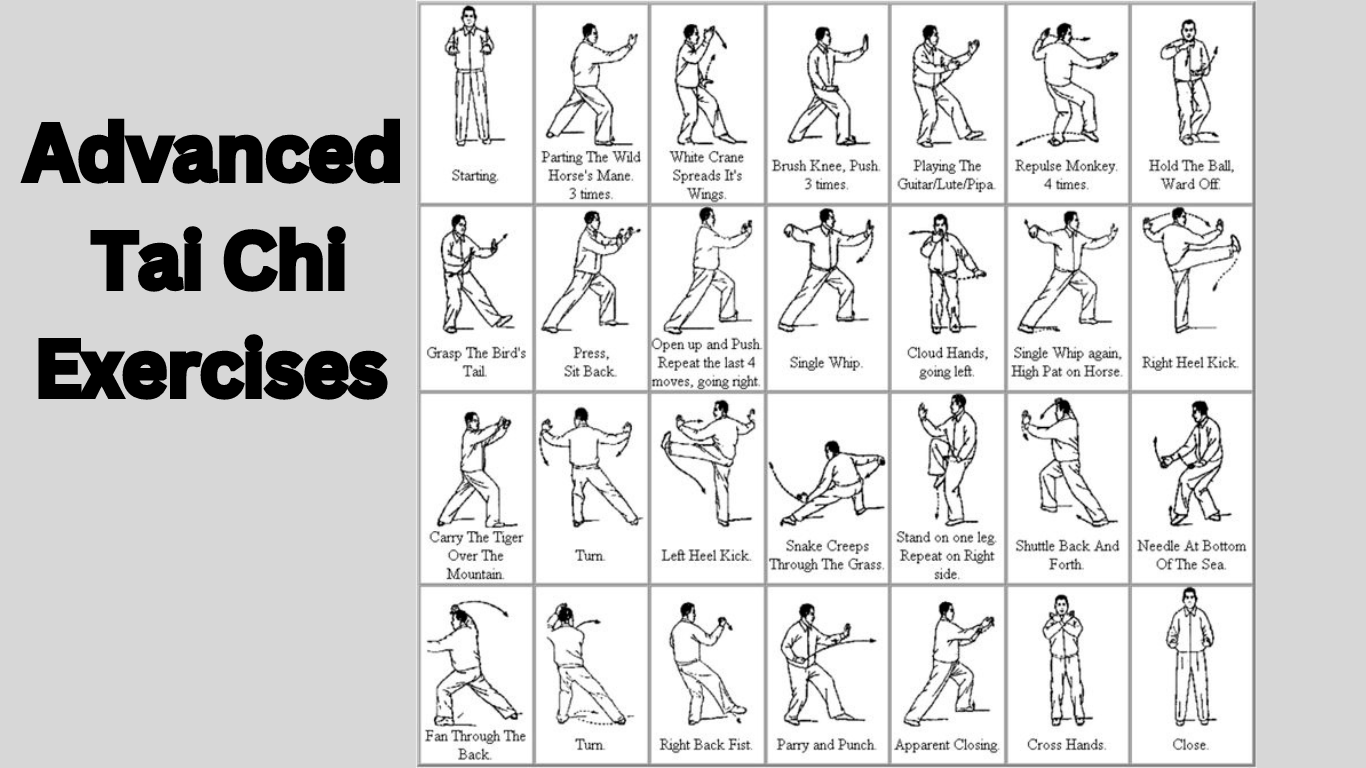
- Tai Chi Chuan 24-Form: Also known as the “Beijing 24-Form,” this sequence is a popular modern form of tai chi designed for beginners and intermediate practitioners. It consists of 24 movements that flow seamlessly from one to the next, encompassing a wide range of tai chi principles such as weight shifting, rotation, and coordination. The Tai Chi Chuan 24-Form is widely practiced for its accessibility and comprehensive benefits, making it an excellent progression for those familiar with basic tai chi movements.
- Yang Style Long Form: The Yang Style Long Form is one of the most traditional and widely practiced forms of tai chi. It consists of a longer sequence of movements that emphasize slow, continuous transitions and deep stances. This form incorporates intricate footwork, hand techniques, and shifts in body alignment, requiring heightened focus and concentration. Practicing the Yang Style Long Form challenges practitioners to refine their tai chi skills while deepening their understanding of balance, agility, and Qi flow.
- Chen Style Tai Chi: Chen Style Tai Chi is known for its dynamic and explosive movements interspersed with slower, more fluid transitions. This form combines powerful bursts of energy with graceful spiraling movements, fostering strength, flexibility, and internal energy cultivation. Chen Style Tai Chi appeals to practitioners seeking a more vigorous and physically demanding practice, integrating martial arts techniques with meditative principles.
- Sun Style Tai Chi: Sun Style Tai Chi incorporates elements of both traditional tai chi and other martial arts forms. It emphasizes smooth, flowing movements combined with agile steps and intricate hand techniques. Sun Style Tai Chi is characterized by its compact and straightforward postures, making it accessible to practitioners of all ages and fitness levels. This form is particularly beneficial for enhancing cardiovascular health, joint mobility, and overall coordination.
When exploring advanced tai chi exercises to do at home, it’s essential to approach these forms with patience, dedication, and a willingness to learn. Advanced techniques often require greater attention to detail in posture, breath control, and mental focus. Consider these tips as you incorporate advanced tai chi forms into your practice:
- Progress Gradually: Begin by familiarizing yourself with the sequence of movements in small segments. Focus on mastering each movement before progressing to the next, ensuring fluidity and precision in your execution.
- Seek Guidance: If possible, seek guidance from a qualified tai chi instructor or participate in workshops to deepen your understanding of advanced techniques. An experienced teacher can provide valuable feedback and corrections to refine your practice.
- Listen to Your Body: Pay attention to your body’s signals during practice. Modify movements as needed to accommodate any physical limitations or discomfort. Tai chi is about harmonizing mind and body, so honor your body’s needs as you progress.
By incorporating advanced tai chi exercises to do at home into your routine, you not only expand your repertoire of movements but also deepen your appreciation for this ancient practice’s transformative power. Whether you choose to explore the Tai Chi Chuan 24-Form, Yang Style Long Form, or other advanced styles, each form offers a unique pathway to enhance physical fitness, mental clarity, and spiritual well-being. Embrace the opportunity to cultivate balance, strength, and inner peace through your continued exploration of tai chi at home.
Health Benefits of Tai Chi
Exploring the health benefits of tai chi exercises to do at home reveals a wealth of evidence and personal testimonials supporting its profound impact on physical and mental well-being. From alleviating chronic conditions to enhancing overall quality of life, tai chi has garnered recognition for its therapeutic value.
Evidence-Based Benefits: Numerous studies have demonstrated the efficacy of tai chi exercises to do at home in improving various health conditions. For instance, research indicates that tai chi can significantly reduce pain and stiffness associated with arthritis, promoting joint flexibility and mobility. The gentle, low-impact nature of tai chi makes it accessible for individuals of all ages and fitness levels, offering a sustainable approach to managing arthritis symptoms.
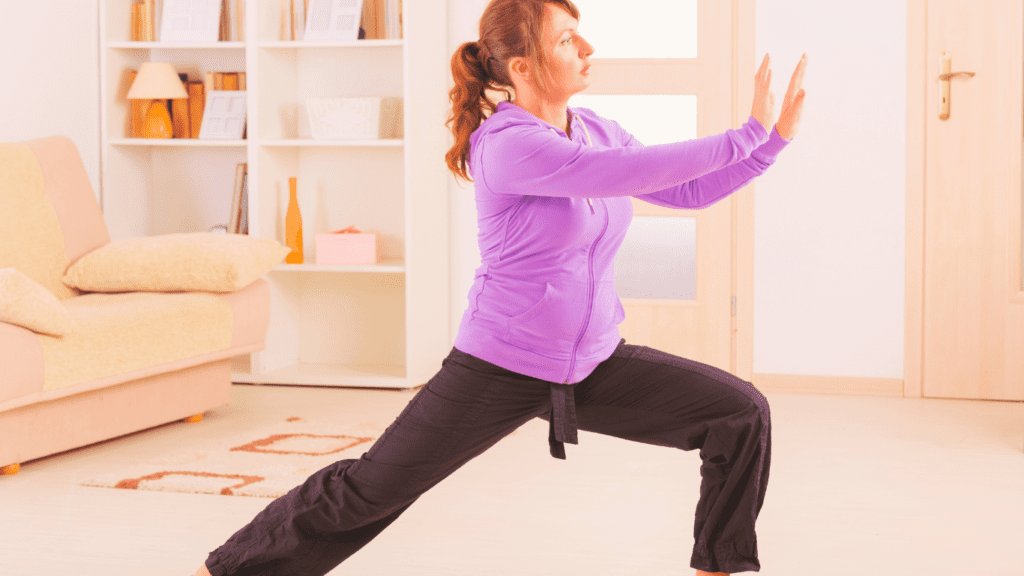
Furthermore, tai chi has been shown to lower blood pressure and improve cardiovascular health. Regular practice can help regulate blood circulation, reduce hypertension, and lower the risk of heart disease. Studies suggest that tai chi’s meditative aspects contribute to stress reduction and mental relaxation, which are crucial for maintaining overall cardiovascular well-being.
Moreover, tai chi enhances balance and coordination, reducing the risk of falls among older adults. By focusing on weight shifting and controlled movements, tai chi improves proprioception and muscle strength, thereby enhancing stability and preventing falls-related injuries.
Personal Testimonials: Beyond scientific evidence, personal testimonials underscore the transformative impact of tai chi exercises at home on individuals’ lives. Many practitioners attest to experiencing increased energy levels, improved sleep quality, and enhanced mental clarity after incorporating tai chi into their daily routines.
Jane, a retiree, shares, “Practicing tai chi at home has been a game-changer for me. It’s not just about physical health; it’s about finding inner peace and balance. I feel more grounded and less stressed, which has positively influenced my overall well-being.”
Similarly, Mark, who manages hypertension, reflects, “I started tai chi to help manage my blood pressure. It’s amazing how such gentle movements can have such a powerful effect. My doctor has noticed a significant improvement, and I feel more in control of my health.”
These personal accounts highlight the holistic benefits of tai chi beyond its physical aspects. The practice fosters a mind-body connection that promotes resilience, emotional well-being, and a sense of inner calm. Whether you’re managing a chronic condition or simply seeking to enhance your overall health, tai chi offers a comprehensive approach to wellness that extends far beyond traditional exercise routines.
The health benefits of tai chi exercises to do at home are supported by both scientific research and personal narratives. By integrating tai chi into your daily life, you embrace a practice that not only strengthens your body but also nourishes your spirit. Whether you’re drawn to its therapeutic benefits for arthritis, hypertension, or balance improvement, tai chi offers a gentle yet effective pathway to holistic health and vitality. Embrace the wisdom of this ancient practice and embark on a journey towards greater well-being, one mindful movement at a time.
The Impact of Tai Chi on Different Health Conditions Chart
| Health Condition | Tai Chi’s Impact | Research Findings | Tips for Practice |
|---|---|---|---|
| Arthritis | Reduces joint pain and stiffness; improves flexibility and mobility. | Studies show that tai chi can decrease pain and improve function in individuals with arthritis. Source: National Center for Complementary and Integrative Health. | Focus on gentle movements and avoid overexertion. Practice regularly to see benefits. |
| Hypertension | Helps lower blood pressure and improve heart health. | Research indicates tai chi can significantly lower systolic and diastolic blood pressure. Source: Journal of Hypertension. | Combine tai chi with deep breathing exercises to maximize cardiovascular benefits. |
| Depression | Enhances mood, reduces symptoms of depression, and promotes relaxation. | Tai chi has been shown to improve symptoms of depression and anxiety. Source: Journal of Clinical Psychiatry. | Practice in a calm, quiet environment to boost mental health benefits. |
| Balance Issues | Improves balance and reduces fall risk, especially in older adults. | Evidence suggests that tai chi significantly improves balance and reduces fall risk among older adults. Source: The Cochrane Library. | Focus on balance-centered movements and practice on a stable surface. |
| Sleep Disorders | Improves sleep quality and reduces insomnia symptoms. | Tai chi practice is associated with better sleep quality and reduced insomnia symptoms. Source: Sleep Medicine Reviews. | Integrate tai chi into your evening routine to promote relaxation before bed. |
| Chronic Pain | Alleviates chronic pain and enhances overall physical function. | Tai chi can be effective in managing chronic pain conditions by improving physical function and reducing pain. Source: Pain Medicine Journal. | Focus on slow, mindful movements to reduce pain and increase comfort. |
| Cognitive Decline | Enhances cognitive function and memory; slows cognitive decline. | Tai chi practice has been linked to improved cognitive function and slower progression of cognitive decline. Source: Journal of Alzheimer’s Disease. | Include mental focus exercises within your practice to support cognitive health. |
Why This Chart is Valuable:
- Targeted Health Benefits: This chart provides detailed information on how tai chi can specifically benefit various health conditions, making the practice more relevant to readers with specific health concerns.
- Evidence-Based Insights: By citing credible research sources, the chart adds credibility and depth to the claims about tai chi’s benefits, helping readers understand the scientific backing behind the practice.
- Practical Tips: Each section includes practical tips for integrating tai chi into the management of specific health issues, offering actionable advice that readers can implement immediately.
- Enhances Existing Content: This chart complements the article by providing new, detailed insights into how tai chi can positively impact specific health conditions, enriching the reader’s understanding and application of tai chi in their daily lives.
Tips for Practicing Alone
Practicing tai chi exercises to do at home offers a unique opportunity for personal growth and well-being. Whether you’re new to tai chi or a seasoned practitioner, developing a solo practice requires dedication and mindfulness to reap its full benefits.
Tips for Practicing Alone:
Self-Correction: One of the challenges of practicing tai chi exercises to do at home is maintaining correct form and technique without direct guidance. Utilize mirrors or record your practice sessions to assess your posture, alignment, and movement. Reflecting on your practice allows you to identify areas for improvement and make necessary adjustments. Pay attention to subtle details such as the positioning of your feet, the alignment of your spine, and the coordination of your breath with each movement. Self-correction fosters a deeper understanding of tai chi principles and promotes continuous growth in your practice.
Consistency: Consistency is key to mastering tai chi exercises at home. Establish a regular practice schedule that fits into your daily routine, whether it’s early morning, during lunch breaks, or before bedtime. Dedicate a specific time and space for your practice to cultivate a sense of ritual and discipline. Start with achievable goals, such as practicing for 15-30 minutes several times a week, and gradually increase the duration and frequency as you progress. Consistent practice not only enhances muscle memory and flexibility but also strengthens your commitment to personal well-being.
As you embark on your solo tai chi journey, consider these additional tips to enrich your practice:
- Mindful Awareness: Cultivate mindful awareness during each movement. Focus on the sensations in your body, the flow of your breath, and the rhythm of your movements. Tai chi is as much a mental practice as it is physical, promoting relaxation, concentration, and stress reduction.
- Variety in Practice: Explore different tai chi styles and forms to expand your repertoire. Experiment with sequences that challenge your coordination and balance, such as the Tai Chi Chuan 24-Form or the Yang Style Long Form. Embrace the diversity within tai chi to keep your practice engaging and dynamic.
- Seek Community and Resources: While practicing tai chi exercises to do at home independently, seek opportunities to connect with a community of practitioners or access online resources. Join virtual classes, forums, or workshops to deepen your understanding of tai chi and share experiences with like-minded individuals. Engaging with others fosters inspiration, motivation, and a sense of belonging within the tai chi community.
By integrating these tips into your solo practice of tai chi exercises to do at home, you empower yourself to cultivate physical health, mental clarity, and emotional well-being. Embrace the journey of self-discovery and personal growth through the ancient art of tai chi. Each practice session offers an opportunity to nurture balance, harmony, and inner peace, contributing to a holistic approach to health and vitality.
Practicing tai chi exercises to do at home allows you to embark on a meaningful journey of self-care and personal development. With self-correction techniques, consistency in practice, and a mindful approach, you can harness the transformative power of tai chi in enhancing your overall quality of life. Embrace the discipline, patience, and dedication required for solo practice, knowing that each step brings you closer to a deeper connection with yourself and the profound benefits of tai chi.
Tai Chi Exercises to Do at Home:Key Variations and Enhancements for Tai Chi Practice Chart
| Aspect | Description | Benefits | Practice Tips |
|---|---|---|---|
| Tai Chi with Props | Incorporate props such as tai chi balls or wands into your practice. | Enhances coordination, strength, and adds variety to practice. Helps in visualizing movements and improving balance. | Start with light props and focus on maintaining form. Use props to aid in balance and coordination. |
| Tai Chi Flow Sequences | Create or follow pre-designed flow sequences that combine multiple forms. | Improves fluidity, rhythm, and overall body integration. Develops the ability to transition smoothly between movements. | Practice each sequence slowly to master transitions. Gradually increase speed as proficiency improves. |
| Tai Chi with Meditation | Combine tai chi movements with seated or standing meditation. | Enhances mental focus, stress relief, and deepens the meditative aspect of tai chi. Integrates mindfulness with movement. | Begin with short meditation sessions and increase duration over time. Synchronize breath with movements. |
| Tai Chi for Specific Goals | Tailor tai chi practice to specific goals such as improving posture or enhancing flexibility. | Addresses individual needs and goals, making practice more relevant and targeted. Increases motivation and personal progress. | Set clear goals and select movements that specifically address those goals. Track progress regularly. |
| Tai Chi with Music | Practice tai chi with calming or rhythmic music in the background. | Enhances relaxation, creates a soothing atmosphere, and can help in maintaining rhythm and pace. | Choose music that is calming and unobtrusive. Adjust volume to a level that supports relaxation. |
| Tai Chi for Energy Flow | Focus on exercises designed to enhance Qi (energy) flow and internal balance. | Promotes energy awareness, improves vitality, and deepens the internal aspects of tai chi. | Incorporate breathing techniques and focus on sensation of energy flow within the body. |
| Tai Chi in Nature | Practice tai chi outdoors in a natural setting such as a park or garden. | Connects with nature, enhances mindfulness, and provides a refreshing change from indoor practice. | Choose a quiet, clean area. Pay attention to natural elements and their impact on your practice. |
| Tai Chi with Partner | Engage in partner tai chi exercises to practice movements with a partner. | Improves social interaction, enhances understanding of movements, and adds a dynamic aspect to practice. | Ensure clear communication with your partner. Start with simple partner exercises and progress gradually. |
| Tai Chi for Core Strength | Incorporate exercises that specifically target core strengthening. | Enhances stability, balance, and overall physical strength. Supports the fundamental principles of tai chi. | Focus on core engagement during movements. Combine with regular core-strengthening exercises. |
Why This Chart is Valuable:
- Diverse Practice Enhancements: By introducing new aspects and variations of tai chi practice, the chart offers readers fresh ideas and methods to deepen and diversify their routine.
- Targeted Benefits: Each variation is linked with specific benefits and practice tips, allowing readers to customize their practice based on their individual goals and needs.
- Enrichment of Existing Content: This chart adds value to the existing article by broadening the scope of tai chi practice beyond the basics of warm-up, practice, and cool-down, providing readers with innovative ways to enrich their experience.
- Practical Implementation: The tips and descriptions make it easy for readers to integrate these variations into their current practice, enhancing their overall engagement and satisfaction with tai chi.
Embracing the Journey: Final Thoughts on Tai Chi Exercises to Do at Home
Throughout this journey exploring tai chi exercises to do at home, we’ve delved into the rich tapestry of this ancient practice and its transformative potential for mind, body, and spirit. From understanding its origins and philosophy to practical tips for starting and advancing your practice, tai chi offers a pathway to holistic well-being that resonates deeply with modern lifestyles.
Recap and Inspiration:
Reflecting on what we’ve learned, tai chi emerges not just as a physical exercise but as a profound journey of self-discovery and healing. Its gentle, flowing movements embody the principles of balance, harmony, and mindfulness, guiding practitioners toward a state of inner peace and vitality.
Through tai chi exercises to do at home, we cultivate strength and flexibility in both body and mind. The structured routines and advanced techniques we’ve explored provide a framework for growth and mastery, encouraging us to push our boundaries and embrace new challenges with resilience and determination.
Moreover, the health benefits of tai chi are well-documented and supported by scientific research. From improving cardiovascular health and enhancing balance to alleviating stress and promoting mental clarity, tai chi offers a comprehensive approach to wellness that spans generations.
As we conclude this exploration, I invite you to embark on your own tai chi journey at home. Start with small steps, dedicating time each day to practice and refine your movements. Embrace the process of self-correction and consistency, knowing that every session brings you closer to achieving your goals and experiencing the profound benefits of tai chi.
Imagine waking up each morning with a sense of calm and purpose, ready to face the day with renewed energy and clarity. Picture yourself moving gracefully through life’s challenges, grounded in the wisdom and serenity cultivated through tai chi practice.
I encourage you to take the first step today. Find a quiet space in your home, roll out your mat or simply stand on a firm surface, and begin with a few minutes of mindful breathing. Gradually incorporate gentle tai chi movements, allowing your body to flow with ease and grace.
As you progress, remember that your journey is unique and deeply personal. Celebrate each milestone, whether it’s mastering a new form or experiencing a moment of profound relaxation. Share your progress and insights with others on this path, building a community of support and encouragement.
In the comment section below, I invite you to share your own experiences with tai chi exercises at home. What benefits have you noticed? How has tai chi enriched your life? Your story may inspire others to embark on their own journey of self-discovery and well-being.
Together, let’s embrace the timeless practice of tai chi as a pathway to a healthier, more balanced life. Let’s cultivate resilience, harmony, and inner peace through each mindful movement and breath. Start today, and let tai chi become not just an exercise, but a transformative practice that nurtures your body, uplifts your spirit, and enriches your overall well-being.
Thank you for joining me on this exploration of tai chi exercises to do at home. May your journey be filled with joy, growth, and profound insights. Here’s to a vibrant future ahead, empowered by the ancient wisdom and enduring benefits of tai chi.


